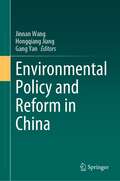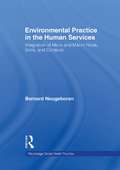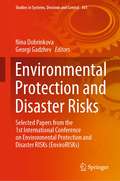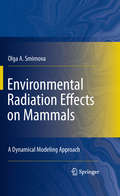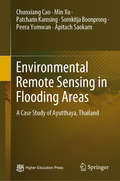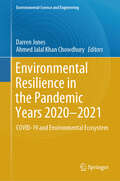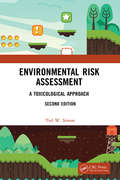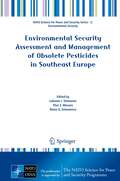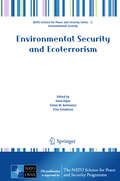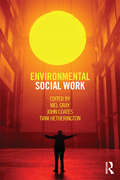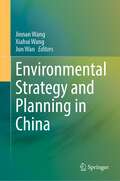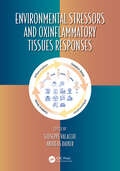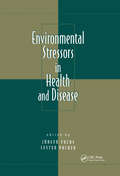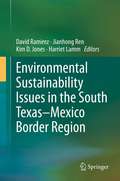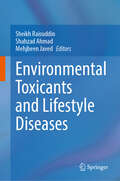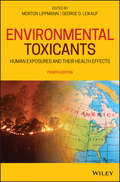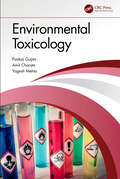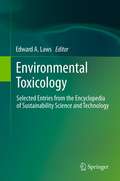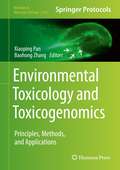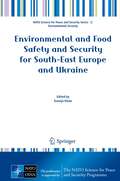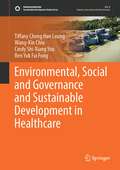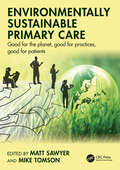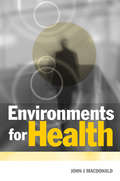- Table View
- List View
Environmental Policy and Reform in China
by Jinnan Wang Hongqiang Jiang Gang YanThe book is the collection of the latest research results from Chinese Academy of Environmental Planning in environmental policy and reform during the past years, mainly related to ecological compensation, the emission trading, the environment audit, carbon tax, environment friendly city, environmental health, economic policy in medical waste, scattered coal treatment subsidies, environmental policy efficiency analysis, environmental industry statistics, environmental performance evaluation, green fiscal and taxation policy, etc., presenting the latest achievements, developments and research trends in this field.
Environmental Pollution and the Brain
by Sultan Ayoub MeoEnvironmental pollution is an emerging global public health problem of both developing and developed nations. Such pollution is a major risk factor for many illnesses, including nervous system disorders. This book combines the highlights the effects of environmental pollution on brain biology. It will be a thorough overview of the pathophysiological and oxidative stress mechanisms and how environmental pollution affects the brain biology. The author discusses environmental pollution and brain development, memory, autism, hearing and vision loss and brain cancer. Several chapters address controversial topics such as the effect of Electromagnetic Field Radiation (RF-EMFR).
Environmental Practice in the Human Services: Integration of Micro and Macro Roles, Skills, and Contexts
by Bernard NeugeborenEnvironmental Practice in the Human Services points to the need for the human services to return to their historic mission of environmental change. It moves beyond the more general conceptual emphasis on person-in-environment toward the development of an environmental practice technology based on an intervention model which prescribes specific micro and macro roles and functions. It may open the way to recapturing the conceptual breadth which characterized the first 40 years of social work as a professional and occupational entity. The “ecological” perspective in social work has fostered an interest in the impact of social environments on service consumers. Environmental Practice in the Human Services tries to rectify the historical imbalance in the human services that has emphasized people-changing methods, giving secondary emphasis to environmental change. It instructs students preparing for practice in the human services, as well as agency practitioners, in the knowledge and skills necessary in environmental practice. Cases in environmental practice are used to illustrate how these skills are utilized in actual practice situations.The book&’s scope includes practice at the direct service, adminstration, planning, and social policy levels; it integrates micro and macro practice and shows how these two levels of practice are interdependent. This enables human service practitioners to create and/or modify social environments to enhance the functioning of clients being served in human service programs. Topics covered include: important skills in environmental practice, including decisionmaking, negotiating, and leadership community practice and resource coordination social support the impact of organizational environments on practice environmental practice for the chronically disabledAuthor Neugeboren&’s approach is unique in its in-depth focus on environmental practice, applying concepts of social environment to specific practice roles. This practice-specific content, which provides tools needed for environmental practice, is in contrast to existing texts on the social environment which are very theoretical and not integrated with practice. He includes material from the field of social ecology which has not been included in existing texts. It shows how practitioners and administrators, planners, and policymakers can facilitate and support each other&’s work.Reading Environmental Practice in the Human Services will enlighten students and practitioners with specific skills for impacting on different social environments to enhance client benefit. It tells how a direct service practitioner can determine which organizational environments are suitable for particular client needs in making agency referrals. It also provides administrators with information about designing, planning, and managing agencies with functional organizational environments which achieve effective services.
Environmental Protection and Disaster Risks: Selected Papers from the 1st International Conference on Environmental Protection and Disaster RISKs (EnviroRISKs) (Studies in Systems, Decision and Control #361)
by Nina Dobrinkova Georgi GadzhevThis book presents research findings and conclusions that has been developed as algorithms or intelligent new methods solving problems in the fields of air pollution, climate and health, natural hazards and risks, water resources, human activities and management and informatics, remote sensing, high-performance computing and GIS for environmental monitoring and management. Environmental protection and disaster risk topics are challenging fields, that scientific world is trying to address as much as it can. Earthquakes, floods, fires, droughts, blizzards, dust storms, natural releases of toxic gases and liquids, diseases and other environmental variations affect hundreds of millions of people each year. Many disaster events are triggered by human activities. Dealing with these problems will require systems thinking and integrating multidisciplinary science. Actions in these directions are taken more and more in the recent years by political bodies, NGOs and scientific groups trying to find sustainable solutions for the future generations. Every point of view matter when it comes to our global home – The Planet Earth.
Environmental Radiation Effects on Mammals
by Olga A. SmirnovaThe monograph is devoted to theoretical studies of radiation effects on mammals. It investigates the effects of both acute and chronic irradiation on vital body systems (hematopoiesis, small intestine, and humoral immunity), on the development of autoimmune diseases and on the mortality dynamics in homogeneous and nonhomogeneous (in radiosensitivity) mammalian populations. All are set within the framework of biologically motivated mathematical models. The developed methodology of the studies, the models themselves, and the obtained results are of a great theoretical significance and can find wide practical use for those dealing with the problems of environmental protection and radiation safety.
Environmental Remote Sensing in Flooding Areas: A Case Study of Ayutthaya, Thailand
by Min Xu Chunxiang Cao Patcharin Kamsing Sornkitja Boonprong Peera Yomwan Apitach SaokarnThis book introduces flood inundation area and flood risks assessment based on a comprehensive monitoring system using remote sensing and geographic information system technologies. Taking the 2011 flood disaster of Ayutthaya in Thailand as an example, it presents a flood intrusion zone identification method based on remote sensing technology, spatial information technology and geographic information system for flood disaster monitoring and early warning system. It introduces the study area and data, vegetation index, improved support vector machine and flood intrusion zone identification method. It also analyzes the flood remote sensing parameters and waterborne diseases, method of risk assessment of waterborne disease outbreak, waterborne disease outbreak risk monitoring based on backpropagation neural network and its expert system. It not only promotes a new interdisciplinary approach both in public health and space information technology, but also greatly supports decision makers in disaster reduction.
Environmental Resilience in the Pandemic Years 2020–2021: COVID-19 and Environmental Ecosystem (Environmental Science and Engineering)
by Darren Jones Ahmed Jalal Khan ChowdhuryThis book focuses on the indirect effects on environmental resilience. The COVID-19 epidemic and the 2020 global pandemic have had an unprecedented public health impact. These included not only economic impacts but also social activities, and environmental and ecological impacts. This study examined the fact that net effects were positive, for example, in terms of greenhouse gas emissions, oil and gas exploration activities, and reductions in pollution. The most notable and most positive environmental impact of COVID-19 is the reduction of greenhouse gas emissions from transportation sources. Air and road transport cause a huge portion of the pollution from closures and outages. Restrictions on economic and social mobility have had positive impacts, with reductions in transport and trade contributing significantly to reducing greenhouse gas emissions. By increasing their scale, endangered ecosystems benefit from improved environmental quality. To better understand how the environment is maintained, we summarize the evolution of COVID-19 and subsequent pandemics. The COVID-19 pandemic has had an unexpected and lasting impact on the environment. At the same time, ecological hotspots where human activity is commonly prevalent benefit from improved environmental quality, allowing wildlife and other life forms to thrive. For this reason, we can conclude that the COVID-19 outbreak and subsequent pandemic were beneficial to environmental stewardship.
Environmental Risk Assessment: A Toxicological Approach
by Ted SimonThe purpose of risk assessment is to support science-based decisions about how to solve complex societal problems. Indeed, the problems humankind faces in the 21st century have many social, political, and technical complexities. Environmental risk assessment in particular is of increasing importance as health and safety regulations grow and become more complicated. Environmental Risk Assessment: A Toxicological Approach, 2nd Edition looks at various factors relating to exposure and toxicity, human health, and risk. In addition to the original chapters being updated and expanded upon, four new chapters discuss current software and platforms that have recently been developed and provide examples of risk characterizations and scenarios. Features: Introduces the science of risk assessment—past, present, and future Provides environmental sampling data for conducting practice risk assessments Considers how bias and conflict of interest affect science-based decisions in the 21st century Includes fully worked examples, case studies, discussion questions, and suggestions for additional reading Discusses new software and computational platforms that have developed since the first edition Aimed at the next generation of risk assessors and students who need to know more about developing, conducting, and interpreting risk assessments, the book delivers a comprehensive view of the field, complete with sufficient background to enable readers to probe for themselves the science underlying the key issues in environmental risk.
Environmental Security Assessment and Management of Obsolete Pesticides in Southeast Europe
by Biana G. Simeonova Fliur Z. Macaev Lubomir I. SimeonovThe present work is a fine contribution to the broad field of environmental security in the context of risk assessment and management of obsolete pesticides for the region of Southeast Europe. The purpose of this book is to evaluate the existing knowledge of improper disposal of obsolete pesticides in the region, to estimate the associated impact on environmental health, and to develop recommendations to mitigate or eliminate threats posed to the environment, biodiversity and human life. The issues discussed in the book include: reviews of the transport and fate of pesticides and associated contaminated materials in different environmental media and identification of the principal sources, emission routes and patterns of environmental pollution with pesticides; a recognition of the most suitable methods for environmental sampling analysis and sample preparation; an evaluation of the current methods and techniques for chemical and mass analysis of environmental and biological samples and discussion of the metrological and quality aspects of trace analyses; a characterization of the environmental and human health impacts of pesticide pollution, the health effects associated with acute and chronic exposure and the use of epidemiological data for risk assessment; a revision of the existing chemical safety regulations and strategies for protection and management of obsolete pesticide stocks; a survey of the international conventions, directives and standards concerning pesticide use.
Environmental Security and Ecoterrorism
by Hami Alpas Simon M. Berkowicz Irina ErmakovaIn recent years, the concept of environmental security has been adapted to include preparedness for acts of ecoterrorism. This latter term has now become synonymous with environmental terrorism where the perpetrator uses the environment as a weapon to harm an opponent. The intended outcome is usually large-scale deaths, severe damage to the environment, and instilling fear in the general population. This book explores various facets of ecoterrorism including the role of the state in pursuing and maintaining environmental security, a review of the concept of ecoterrorism, food security challenges and weaknesses, technological countermeasures to enable rapid detection or response, and existing pollution sources and hazards that may serve as targets for terrorist acts. In sum, this volume provides a useful overview for both the layperson and experienced researchers.
Environmental Social Work: Racial Preference In Black And White (Positions: Education, Politics, And Culture Ser.)
by Tim J. WiseSocial work has been late to engage with the environmental movement. Often working with an exclusively social understanding of environment, much of the social work profession has overlooked the importance of environmental issues. However, recently, the impact of and worldwide attention to climate change, a string of natural disasters, and increased understanding of issues around environmental justice has put the environment, sustainability, and well-being in the spotlight. Divided into three parts, this field-defining work explores what environmental social work is, and how it can be put into practice. The first section focuses on theory, discussing ecological and social justice, as well as sustainability, spirituality and human rights. The second section comprises case studies of evolving environmental social work practice. The case studies derive from a range of areas from urban gardens and community organizing to practice with those affected by climate change. The final section – relevant to students and lecturers – looks at learning about environmental issues in social work. Environmental Social Work provides an integrated theoretical and practical overview of why and how social work might respond to environmental factors affecting the societies and people they work with at international, national, local and individual levels.
Environmental Strategy and Planning in China
by Jun Wan Jinnan Wang Xiahui WangThis book covers the research fields in biodiversity conservation, the Belt and Road eco-environmental cooperation, China's five-year plan for eco-environmental protection, sustainable development goals assessment, and human health loss assessment. In the past, these achievements have played an important scientific role in supporting China's ecological and environmental protection, and produced extensive social impacts and significant environmental benefits. At the same time, the relevant research ideas and methods also show the latest progress and trend in the field of environmental strategy and planning in China in recent years, which can be used for reference by experts and scholars of other countries in the field of ecological environment.
Environmental Stressors and OxInflammatory Tissues Responses (Oxidative Stress and Disease #53)
by Giuseppe Valacchi Andreas DaiberEnvironmental risk factors – noise, air pollution, chemical agents, and ultraviolet radiation – impact human health by contributing to the onset and progression of noncommunicable diseases. Accordingly, there is need for preclinical and clinical studies and comprehensive summary of major findings. This book is a state-of-the-art summary of these myriad severe life stressors. The chapters on the different pollutants focus on disease mechanisms (cardiovascular, neurological and metabolic disorders) and on oxidative stress and inflammation. The editors emphasize emerging mechanisms based on dysregulation of the circadian clock, the microbiome, epigenetic pathways, and cognitive function by environmental stressors, and introduce the exposome concept while highlighting existing research gaps. Key Features: · Links various environmental stressors to the incidence of noncommunicable diseases · Includes chapters on airborne toxins, chemical pollutants, noise, and ultraviolet radiation stressors · Contributions from an international team of leading researchers · Summarizes the impacts of stressors on disease mechanisms
Environmental Stressors in Health and Disease
by Jurgen FuchsThis volume illustrates the impact of environmental oxidants on the tissues of the eyes, lungs and skin, as well as on the immune system - highlighting common illnesses, injuries and pathologies induced by pro-oxidant environmental xenobiotics such as inflammation, immune response, signal transduction, regulation of gene expression, and carcinogenesis. It provides clinical presentations and discusses the effects of environmental oxidants on target organs.
Environmental Sustainability Issues in the South Texas–Mexico Border Region
by Harriet Lamm Jianhong Ren David Ramirez Kim D. JonesEnvironmental sustainability issues in a fragile, semi-arid region and its coastal area, which experience climate changes from extreme drought conditions to the effects of hurricanes over a period of weeks to years, provide specific challenges for the ecosystems and the populations existing within the region. The research presented focuses on the problems and some solutions specific to the South Texas-Mexico border region, on both sides of the Rio Grande, focusing on water and air pollution.
Environmental Toxicants and Lifestyle Diseases
by Mehjbeen Javed Sheikh Raisuddin Shahzad AhmadThis book discusses the relationship between environmental toxicants and lifestyle diseases and explores how pollutants impact human health. With contributions from leading experts, this volume delves into the latest research and evidence-based approaches to understanding and managing these critical health issues. The chapters cover a wide array of topics, including emerging contaminants like endocrine disruptors and microplastics. The book also covers the link between environmental toxicants and diseases such as obesity, diabetes, cardiovascular conditions, cancer, infertility, chronic lung diseases, and stress. Additionally, it explores innovative management strategies for these lifestyle diseases through nanotechnological applications, natural products, and dietary interventions. Researchers in toxicology, biochemistry, environmental science, clinical research, and related fields will find this book invaluable. It provides critical insights for regulatory agencies, policymakers, health professionals, and students at all levels.
Environmental Toxicants: Human Exposures and Their Health Effects
by Morton Lippmann George D. LeikaufAn Updated Reference on Human Exposure to Environmental Toxicants and A Study of Their Impact on Public Health With the 4th edition of Environmental Toxicants: Human Exposures and Their Health Effects, readers have access to up-to-date information on the study and science of environmental toxicology and public health worldwide. Practitioners and professionals can use this resource to understand newly discovered information on the adverse health effects of toxins and pollutants in air, water, and occupational and environmental environments on large human populations. The 4th edition of this book is updated to reflect new knowledge and research on: ● Performing risk assessments on exposed individuals ● Assessing the effects of toxicants and substances on large populations for health and medical professionals ● Patterns of human exposure to select chemical toxicants ● World Trade Center dust, agents for chemical terrorism, and nanoparticles For health professionals, including health authorities, public health officials, physicians, and industrial managers, who are seeking new research and techniques for managing environmental substances, this invaluable reference will guide you through in a thorough, easy- to-read manner.
Environmental Toxicity of Nanomaterials
by Vineet Kumar Shivendu Ranjan Nandita DasguptaEnvironmental Toxicity of Nanomaterials focuses on causes and prevention of environmental toxicity induced by various nanomaterials. In sixteen chapters it describes the basic principles, trends, challenges, and future directions of nanoecotoxicity. The future acceptance of nanomaterials in various industries depends on the impacts of nanomaterials on the environment and ecosystem. This book analyzes the safe utilization of nanotechnology so the tremendous prospect of nanotechnology can be achieved without harming either living beings or the environment. Environmental Toxicity of Nanomaterials introduces nanoecotoxicity, describes various factors affecting the toxicity of nanomaterials, discusses various factors that can impart nanoecotoxicity, reviews various studies in the area of nanoecotoxicity evaluation, and describes the safety and risk assessment of nanomaterials. In addition, the book discusses strategies for mitigating nanoecotoxicity. Lastly, the authors provide guidelines and protocols for nanotoxicity evaluation and discuss regulations for safety assessment of nanomaterials. In addition to environmental toxicologists, this book is aimed at policy makers, industry personnel, and doctoral and postdoctoral scholars.
Environmental Toxicology
by Pankaj Gupta Amit Chanjta Yogesh MehtaEco-toxicology, an offshoot of toxicology, is a multidisciplinary science that integrates toxicology and ecology by drawing knowledge and procedures from both fields. It analyses the effects of toxic chemicals or biological agents on living organisms at different levels of organization. Eco-toxicology classifies different contaminants, their characteristics, release and ecological fate, and predicts their effects so that timely action can be taken to prevent or minimize any detrimental effects. Environmental Toxicology starts with the basics of toxicology, briefly touching on the sources of toxic compounds, classification of toxicants, and factors affecting toxicity, and then elaborates on heavy metal toxicity. The individual chapters on various heavy metals and radioactive metals discuss the sources and routes of exposure, aetiology, pathophysiology, clinical manifestations, and mechanisms of toxicity, toxicological effects, diagnosis, treatment, management, and ecological impact. The book covers the field in its greatest width and provides an insight into pesticide and radiation toxicity, and recent advances in eco-toxicology, with special focus on the removal of HMs and the latest bioremediation techniques. This book serves as a reference work for advanced students pursuing degrees in environmental toxicology and across various disciplines, such as biomedical and environmental sciences, toxicology, eco-toxicology, pharmacology, public health, etc. and all interested in learning the concepts of eco-toxicology. Features: A systematic overview of the key concepts of eco-toxicology, its relationship with other disciplines, and recent advances in the area Detailed classification of toxicants, types of toxicity, and mechanism of the action of toxicants An in-depth coverage of topics on the mechanism toxicity of HMs, in addition to exclusive sections on pesticide and radiation toxicity A fact file in each chapter, highlighting its key points Flow charts, tables, diagrams, and illustrations in easily understandable language
Environmental Toxicology
by Edward A. LawsEnvironmental Toxicology provides a detailed, comprehensive introduction to this key area of sustainability and public health research. The broad coverage includes sections on ecological risk assessment, monitoring, mechanisms, fate and transport, prevention, and correctives, as well as treatment of the health effects of solar radiation and toxicology in the ocean. The 23 state-of-the-art chapters provide a multi-disciplinary perspective on this vital area, which encompasses environmental science, biology, chemistry, and public health.
Environmental Toxicology and Toxicogenomics: Principles, Methods, and Applications (Methods in Molecular Biology #2326)
by Baohong Zhang Xiaoping PanThis detailed book provides an accessible compendium of up-to-date methods in the fields of environmental toxicology, molecular toxicology, and toxicogenomics. Organized into four major sections, the volume examines methods utilizing model animal species, such as nematode, fruit fly, mice, chicken, and amphibians, methods using plants to study chemical toxicity, applying the Ames assay to chemical mutagenicity study, as well as methods for environmental chemical analysis. Although this book is divided into these parts, the methods can be used across species. Written for the highly successful Methods in Molecular Biology series, chapters include introductions to their respective topics, lists of the necessary materials and reagents, step-by-step, readily reproducible laboratory protocols, and tips on troubleshooting and avoiding known pitfalls. Authoritative and practical, Environmental Toxicology and Toxicogenomics: Principles, Methods, and Applications serves as a valuable resource for the scientific community, particularly for young scientists and graduate and undergraduate students, inspiring more research in the vitally important field of environmental toxicity, molecular toxicology, and toxicogenomics.
Environmental and Food Safety and Security for South-East Europe and Ukraine
by Ksenija VitaleThis book covers important aspects of the field of food security and safety, ranging from fundamental production, through advanced water treatment technologies and detection of novel pollutants, to management and policy making. The discussion strives to develop an integrated approach to solving the associated problems by simultaneously considering sociological, ecological and economic aspects. Special focus is on the environmental management systems that should be integrated in the processes of environmental risk assessment. Also addressed are other technologies applied in the service of detecting, preventing and monitoring possible threats to food security and safety. With its variety of subjects, this volume can serve both as a textbook for advanced studies and as a useful reference source for professionals.
Environmental, Social and Governance and Sustainable Development in Healthcare (Sustainable Development Goals Series)
by Ben Yuk Fong Tiffany Cheng Leung Wang-Kin Chiu Cindy Shi-Xiang YouThis book applies environmental, social and governance (ESG) to issues of sustainable development in healthcare. ESG reporting has been widely used for some time in the business industry to show the economic, social and environmental responsibilities of companies that aim to achieve superior ESG performance for lower risk, more accountability and transparency. Moreover, public-listed companies in healthcare have been growing in significant numbers in recent years. The application or practice of ESG in healthcare has become a growing trend for these large organisations looking to demonstrate their strengths in areas of financing, operations, sustainability and social responsibilities. Such an approach is essential not only for the long-term development of the companies but also for services delivered by healthcare practitioners. Equally, the implications to Sustainable Development Goal (SDG) 3 is relevant to healthcare worldwide with a growing ageing population, which has led to a great burden of care in many countries, particularly in the public sector. The potential development and expansion in private healthcare services, accelerated by technology advancement, has demanded a new paradigm in the healthcare industry, particularly in business, service delivery and policy. The book examines this paradigm through health in all policies, ESG and SDG 3 objectives, research, training and practice. It is relevant to graduate students and scholars working in areas relating to health, business and the SDGs and is also useful to policymakers and practitioners in healthcare.
Environmentally Sustainable Primary Care: Good for the planet, good for practices, good for patients
by Matt Sawyer Mike TomsonThis practical guide for primary care provides a context-specific introduction to the sustainability challenges associated with good health-care delivery and provides easy-to-implement yet impactful actions that can be taken to reduce and mitigate the impact of primary care on the living world while also looking at the impact of the changing planet on health care that people will encounter.The chapters address the following key questions: What is the issue? What can I do/what can my practice do? How do my actions help patients, practice, and planet? Included throughout are case studies, vignettes, and anecdotes of previous successful interventions, while a checklist of the most impactful actions for others to follow, as supported by the current evidence base, provides a convenient summary. References and additional resource recommendations give directions for further guidance. The book looks at the four pillars of primary care – dentistry, General Practice, optometry, and pharmacy – and includes international contributions.Providing invaluable direction to turn good intentions into meaningful action, this book will be invaluable to health professionals and practice managers across all primary care disciplines and to students preparing to enter practice in those fields. It will also be of interest to integrated care system administrators and to health policymakers.
Environments for Health
by John MacDonald'John Macdonald once again turns the traditional approach to health care on its head. Instead of merely diagnosing and managing disease, he urges health services ? and indeed society ? to foster health ... and articulates a vision of a health promoting ? a salutogenic ? society'. Dimity Pond, School of Medical Practice and Population Health, University of Newcastle, Australia The vast proportion of cash spent on health care by governments and individuals in the world is spent on systems that are based on a more or less Westernized acute care model. The imbalance of these systems, with their overemphasis on cure, as opposed to care and prevention or maintenance of health, is well documented. Salutogenic health care takes a holistic view of the individual as part of a social and environmental continuum rather than as an isolated packet of symptoms, and seeks to reassess the very meaning of health. There are some indications that we, as a global culture, are moving towards this new salutogenic model, but the speed of the movement has to be accelerated. This book sets out to chart the main steps of this movement and to indicate some of the ways of thinking and action which can help form new ways of approaching health care.
